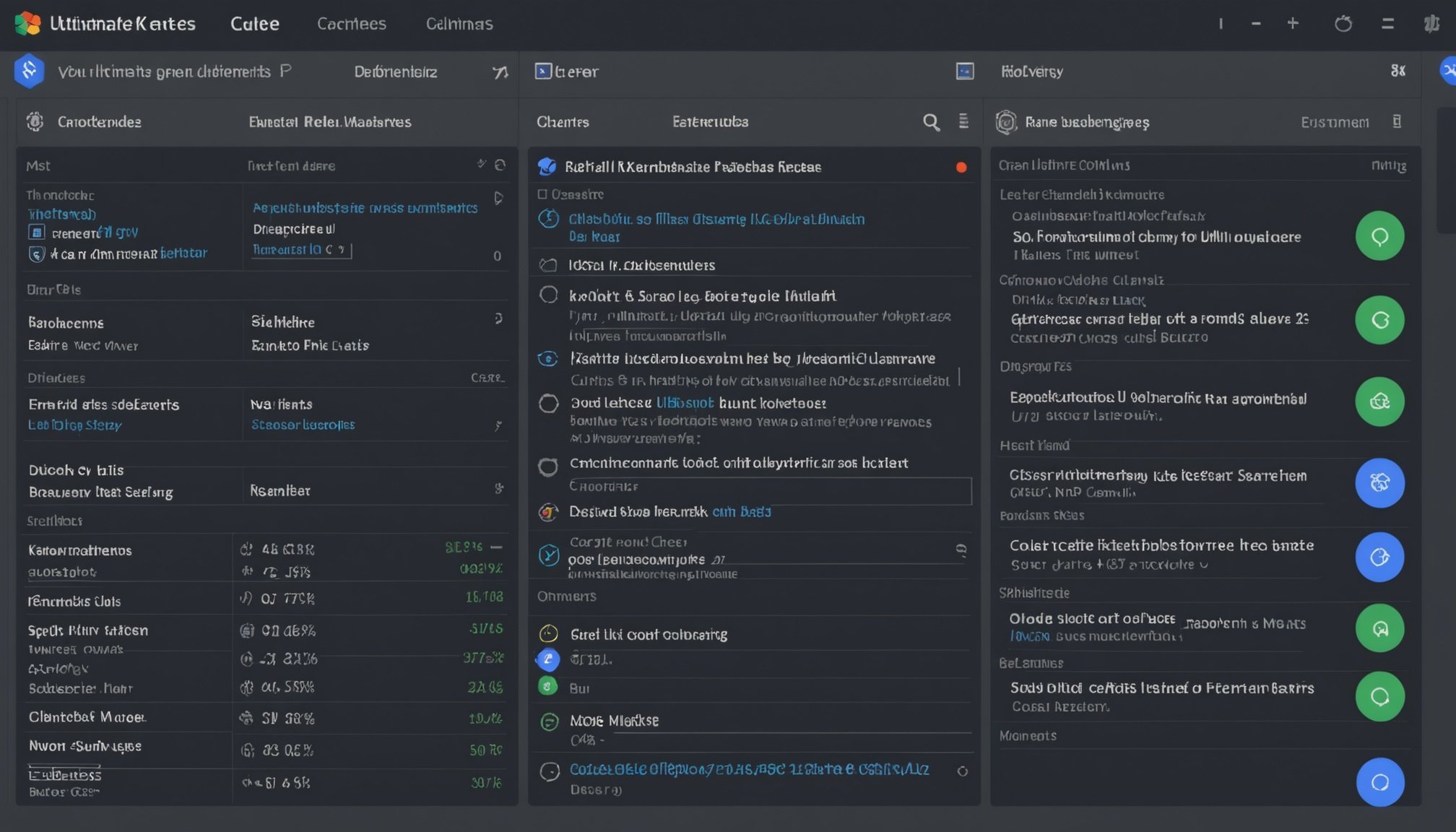Ultimate Kubernetes Guide: Efficiently Auto-Scale Your Cluster by Monitoring CPU Usage to Kubernetes Autoscaling
Kubernetes, the powerful container orchestration platform, offers robust autoscaling capabilities that can dynamically adjust your application’s resources based on demand. This feature is crucial for ensuring high availability, optimizing resource usage, and reducing costs. In this guide, we will delve into the world of Kubernetes autoscaling, focusing on how to efficiently auto-scale your cluster by monitoring CPU usage.
Understanding the Horizontal Pod Autoscaler (HPA)
The Horizontal Pod Autoscaler (HPA) is Kubernetes’ primary autoscaling solution, designed to adjust the number of pod replicas based on resource metrics such as CPU and memory utilization.
Also read : Unlocking seamless automation: expert strategies for multi-account deployments with aws cloudformation
How HPA Works
HPA implements a continuous control loop mechanism in your Kubernetes cluster, monitoring resource utilization every 15 seconds by default. Here’s a step-by-step breakdown of how HPA operates:
- Monitoring Resource Utilization: HPA evaluates metrics from the Metrics Server, comparing current usage against target thresholds to determine the optimal number of pod replicas[3][5].
- Scaling Decisions: If the current resource usage exceeds the target, HPA increases the number of running pods. Conversely, if the usage is below the target, HPA reduces the number of pods to save resources[5].
- Configuration: You can configure HPA using a YAML file or the
kubectl autoscalecommand. This configuration includes defining the scaling rules and which metrics to monitor, such as CPU, memory, or custom metrics[5].
Example Configuration
Here’s an example of how you might configure HPA for a deployment:
Additional reading : Unlocking the power of aws elastic beanstalk: your ultimate guide to seamlessly deploying scalable web applications
apiVersion: autoscaling/v2
kind: HorizontalPodAutoscaler
metadata:
name: demo
spec:
scaleTargetRef:
apiVersion: apps/v1
kind: Deployment
name: demo
minReplicas: 3
maxReplicas: 9
metrics:
- type: Resource
resource:
name: cpu
target:
type: Utilization
averageUtilization: 50
This configuration specifies that Kubernetes should scale the deployment between three and nine pods to maintain an average CPU utilization of 50%[5].
Using the Vertical Pod Autoscaler (VPA)
While HPA adjusts the number of pod replicas, the Vertical Pod Autoscaler (VPA) dynamically adjusts the resources allocated to pods.
Components of VPA
VPA consists of several key components:
- Recommender: Monitors current and past resource consumption to provide recommended values for the containers’ CPU and memory requests[1].
- Updater: Checks which managed pods have correct resources set and, if not, kills them so they can be recreated by their controllers with the updated requests[1].
- Admission Controller: Sets the correct resource requests on new pods, either just created or recreated by the Updater[1].
How VPA Works
VPA watches node resource usage via the Kubernetes API and automatically adjusts both requests and limits for containers and pods accordingly. Here are some key aspects of VPA:
- Resource Adjustment: VPA can downscale pods that are over-requesting resources and upscale pods that are under-requesting resources based on their usage over time[1].
- Integration with HPA: VPA can work in conjunction with HPA to ensure that both the number of pods and the resources allocated to each pod are optimized[1].
The Role of the Cluster Autoscaler (CA)
The Cluster Autoscaler (CA) is another critical component of Kubernetes autoscaling, focusing on adjusting the number of nodes in the cluster.
How CA Works
CA monitors pod resource requests and adjusts the number of nodes accordingly:
- Scaling Up: CA provisions new nodes when it detects resource constraints that prevent pods from being scheduled[2].
- Scaling Down: CA removes underutilized nodes after a 10-minute grace period to optimize costs[2].
- Cloud Integration: CA integrates with major cloud providers to manage virtual machines, ensuring efficient workload distribution and optimal resource utilization[2].
Best Practices for CA
Here are some best practices to keep in mind when using CA:
| Feature | Description |
|---|---|
| Scale Up | Automatically adds nodes when pods are unschedulable due to resource constraints. |
| Scale Down | Removes underutilized nodes to reduce costs. |
| Cloud Integration | Works with major cloud providers for virtual machine management. |
| Resource Monitoring | Continuously tracks pod scheduling and node utilization. |
- Resource Management: Ensure the Cluster Autoscaler pod has at least one dedicated CPU core, and configure precise resource requests for all pods to enable accurate scaling decisions[2].
- Infrastructure Configuration: Specify multiple node pools across different availability zones and use capacity reservations to ensure compute resources are available during critical events[2].
Monitoring and Metrics in Kubernetes Autoscaling
Effective autoscaling relies heavily on accurate and real-time monitoring of resource usage.
Metrics Server
The Metrics Server is a lightweight Kubernetes add-on that provides resource usage metrics. Here’s how to install it:
kubectl apply -f https://github.com/kubernetes-sigs/metrics-server/releases/latest/download/components.yaml
This server is essential for both HPA and VPA to function correctly, as it provides the necessary metrics for scaling decisions[4].
Custom Metrics
In addition to CPU and memory metrics, you can use custom metrics that directly impact your application’s performance:
- Response Times: For user-facing services.
- Queue Lengths: For background jobs.
- Custom Business Metrics: That influence scaling decisions[2].
Best Practices for Kubernetes Autoscaling
To ensure your Kubernetes autoscaling implementation is efficient and effective, follow these best practices:
Monitor Like a Pro
Use powerful tools like Prometheus and Grafana to collect metrics and provide deep insights into your application’s performance patterns and resource consumption.
Choose Your Metrics Wisely
Select metrics that are relevant to your application. While CPU and memory metrics are common, consider other metrics that directly impact your application’s performance.
Configuration and Implementation
- Ensure Precise Resource Requests: Configure precise resource requests for all pods to enable accurate scaling decisions.
- Avoid Manual Node Pool Management: When using the Cluster Autoscaler, avoid manual node pool management to prevent conflicts.
- Use Capacity Reservations: Ensure compute resources are available during critical events by using capacity reservations[2].
Practical Example: Scaling a Deployment on EKS
Here’s a practical example of how to set up and scale a deployment on an Amazon EKS cluster using HPA:
Create an EKS Cluster and Node Group
First, create an EKS cluster and a node group. You can use the AWS CLI to configure your kubectl to point to the EKS cluster:
aws eks --region <region-code> update-kubeconfig --name <cluster-name>
Install the Metrics Server
Install the Metrics Server to provide resource usage metrics:
kubectl apply -f https://github.com/kubernetes-sigs/metrics-server/releases/latest/download/components.yaml
Deploy the Application
Create a Deployment.yaml file and deploy your application:
apiVersion: apps/v1
kind: Deployment
metadata:
name: sample
spec:
replicas: 1
selector:
matchLabels:
app: sample
template:
metadata:
labels:
app: sample
spec:
containers:
- name: my-app-container
image: <account-id>.dkr.ecr.us-east-1.amazonaws.com/sample:latest
ports:
- containerPort: 80
resources:
requests:
cpu: "100m"
limits:
cpu: "500m"
Configure HPA
Create a scale.yaml file to configure HPA:
apiVersion: autoscaling/v1
kind: HorizontalPodAutoscaler
metadata:
name: sample-hpa
spec:
scaleTargetRef:
apiVersion: apps/v1
kind: Deployment
name: sample
minReplicas: 1
maxReplicas: 10
targetCPUUtilizationPercentage: 50
Apply the HPA configuration:
kubectl apply -f scale.yaml
Kubernetes autoscaling is a powerful feature that can significantly enhance the efficiency and reliability of your cloud-native infrastructure. By understanding and leveraging the Horizontal Pod Autoscaler, Vertical Pod Autoscaler, and Cluster Autoscaler, you can ensure that your cluster scales dynamically to meet the demands of your application.
Key Takeaways
- Monitor Resource Usage: Use tools like the Metrics Server, Prometheus, and Grafana to monitor resource usage effectively.
- Choose the Right Autoscaler: Select between HPA, VPA, and CA based on your specific needs.
- Configure Precisely: Ensure precise resource requests and configure autoscalers to match your application’s performance metrics.
- Test and Optimize: Continuously test and optimize your autoscaling configurations to ensure they align with your application’s needs.
By following these guidelines and best practices, you can efficiently auto-scale your Kubernetes cluster, ensuring optimal resource utilization and high availability for your applications.
Table: Comparison of Kubernetes Autoscalers
| Feature | Horizontal Pod Autoscaler (HPA) | Vertical Pod Autoscaler (VPA) | Cluster Autoscaler (CA) |
|---|---|---|---|
| Scaling Mechanism | Adjusts pod replicas based on metrics | Adjusts resources allocated to pods | Adjusts the number of nodes in the cluster |
| Metrics Used | CPU, memory, custom metrics | CPU, memory usage | Pod resource requests, node utilization |
| Use Case | Stateful and stateless workloads | Workloads with dynamic resource needs | Large clusters with varying pod resource requirements |
| Configuration | YAML or kubectl autoscale command |
YAML configuration | YAML configuration |
| Integration | Works with Deployment, ReplicaSet, StatefulSet | Works with HPA | Integrates with cloud providers for VM management |
This table provides a quick comparison of the different autoscalers available in Kubernetes, helping you choose the right tool for your specific needs.
Quotes and Insights
- “Kubernetes autoscaling is a powerful resource management feature that automatically adjusts your cloud-native infrastructure based on workload demands.”[2]
- “The Horizontal Pod Autoscaler is a highly popular solution for autoscaling, with over half of Kubernetes organizations adopting it to scale their workloads.”[1]
- “Effective autoscaling relies heavily on accurate and real-time monitoring of resource usage, making tools like the Metrics Server and Prometheus essential.”[2]
By leveraging these insights and best practices, you can master Kubernetes autoscaling and ensure your cluster operates efficiently and effectively.











